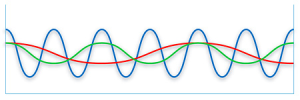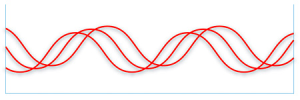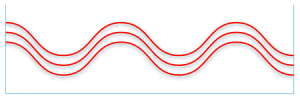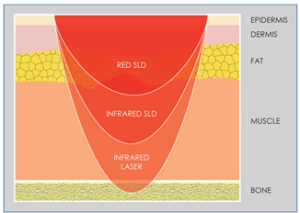Low Level Laser Therapy
Drug-free pain relief and healing
“The use of low levels of visible or near infrared light for reducing pain, inflammation and edema, promoting healing of wounds, deeper tissues and nerves, and preventing cell death and tissue damage has been known for over forty years”
Prof. Michael Hamblin, Harvard-MIT Division of Health Science & Technology Mechanisms of Low Level Light Therapy
Low Level Laser Therapy does not heat or cut tissue, unlike high intensity lasers.
Many pharmacological treatments (medications) mask pain or only address the symptoms of the disease. Low Level Laser Therapy treats the underlying condition or pathology to promote healing, reduce inflammation and give relief for both acute and chronic pain. This means that the treatments are effective and the benefits of Low Level Therapy are long lasting.
L-A-S-E-R is an acronym that stands for Light Amplification by Stimulated Emission of Radiation. In simple terms this refers to light waves of a specific wavelength.
Sun light is a mixture of seven different colours, is disorderly and is not parallel.
Low level laser light is compressed light of a wavelength from the cold, red part of the spectrum of electromagnetic radiation. It’s different from natural light in that it’s one precise colour, coherent (it travels in a straight line), runs parallel (collimated), monochromatic (a single wavelength) and polarised (it concentrates its beam in a defined location or spot). The healing properties of Laser Light come from these differences.
Laser Pain Therapy
Low level laser therapy is a Western form of treatment used for over 30 years internationally. It is not the same as laser acupuncture. It is supported by scientific research, evidence and controlled trials including research from Harvard University and NASA. NASA Light-Emitting Diode Technology Brings Relief In Clinical Trials
LLLT utilises low powered wavelengths of light in the infra-red and far infrared spectrum which has no effect on normal tissue but is active where there is injury or inflammation.
Red and near-infrared light wavelengths of 600-1070nm penetrate tissue maximally. The technology utilizes superluminous (light emitting) and laser diodes to irradiate diseased or traumatised tissue with photons.
One important way in which laser therapy adds energy is through photon absorption by mitochondria. These tiny organelles which have been called the “powerhouses” of the cell, are found in most plants and animals. Mitochondria are able to absorb laser light which then activates a series of reactions to increase and store more cellular energy in the form of adenosine triphosphate (ATP).
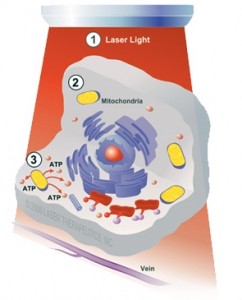
By increasing energy available in this readily accessible form, laser light is able to greatly stimulate the biological function of cells, tissue, and systems and even raise overall vital energy throughout the individual.
“Bio” stimulation = Life stimulation!
When energy is available, the body can heal itself.
Laser therapy has been shown to stimulate the regeneration of bone, blood, the lining of blood vessels, cartilage, nerve, muscle and much more. Moreover, it has been documented to enhance the quality of healed tissue. Laser therapy may be an ideal treatment. It may not only effectively address many medical conditions but also has been widely reported to improve health and wellbeing as evidenced by a host of biological markers.
The process is curative and therefore results in the elimination of symptoms including pain. In addition, it enhances the body’s immune system response and facilitates natural healing.
LLLT actually improves healing, as well as reducing inflammation and pain.
LLLT is curative because it works at the cellular level rather than modulating symptomatology.
Intracellular biomolecules respond, resulting in the restoration of normal cell function. This stimulates, promotes, enhances and accelerates the healing process.

